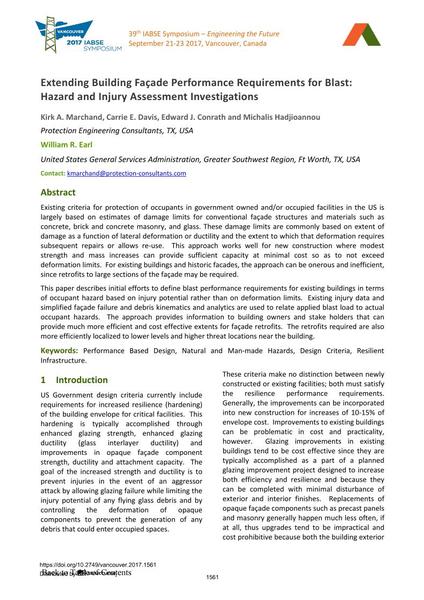Extending Building Façade Performance Requirements for Blast: Hazard and Injury Assessment Investigations

|
|
|||||||||||
Détails bibliographiques
| Auteur(s): |
Kirk A. Marchand
(Protection Engineering Consultants, TX, USA)
Carrie E. Davis (Protection Engineering Consultants, TX, USA) Edward J. Conrath (Protection Engineering Consultants, TX, USA) Michalis Hadjioannou (Protection Engineering Consultants, TX, USA) William R. Earl (United States General Services Administration, Greater Southwest Region, Ft Worth, TX, USA) |
||||
|---|---|---|---|---|---|
| Médium: | papier de conférence | ||||
| Langue(s): | anglais | ||||
| Conférence: | IABSE Symposium: Engineering the Future, Vancouver, Canada, 21-23 September 2017 | ||||
| Publié dans: | IABSE Symposium Vancouver 2017 | ||||
|
|||||
| Page(s): | 1561-1568 | ||||
| Nombre total de pages (du PDF): | 8 | ||||
| Année: | 2017 | ||||
| DOI: | 10.2749/vancouver.2017.1561 | ||||
| Abstrait: |
Existing criteria for protection of occupants in government owned and/or occupied facilities in the US is largely based on estimates of damage limits for conventional façade structures and materials such as concrete, brick and concrete masonry, and glass. These damage limits are commonly based on extent of damage as a function of lateral deformation or ductility and the extent to which that deformation requires subsequent repairs or allows re-use. This approach works well for new construction where modest strength and mass increases can provide sufficient capacity at minimal cost so as to not exceed deformation limits. For existing buildings and historic facades, the approach can be onerous and inefficient, since retrofits to large sections of the façade may be required. This paper describes initial efforts to define blast performance requirements for existing buildings in terms of occupant hazard based on injury potential rather than on deformation limits. Existing injury data and simplified façade failure and debris kinematics and analytics are used to relate applied blast load to actual occupant hazards. The approach provides information to building owners and stake holders that can provide much more efficient and cost effective extents for façade retrofits. The retrofits required are also more efficiently localized to lower levels and higher threat locations near the building. |
||||
